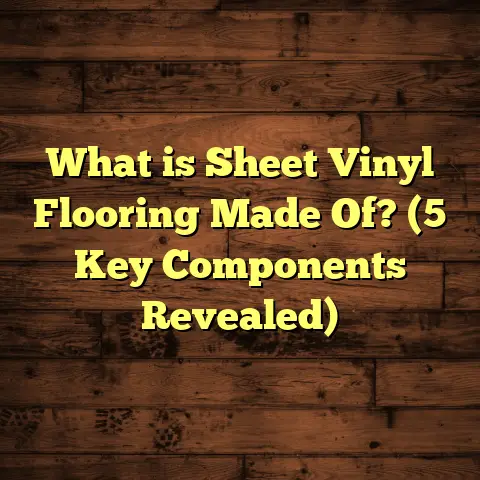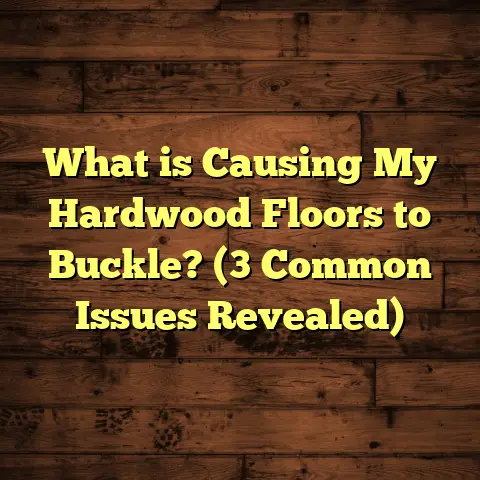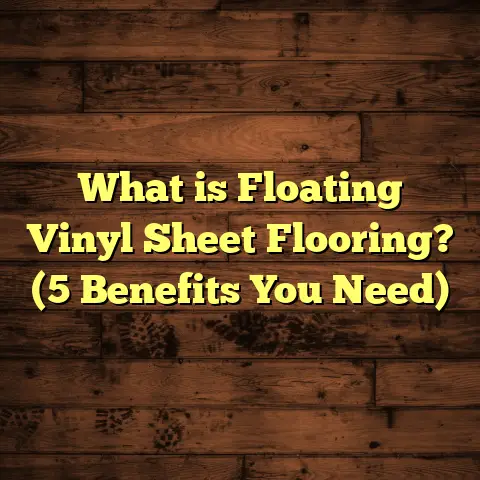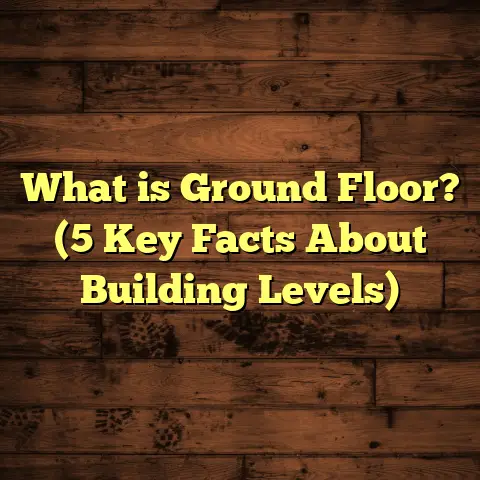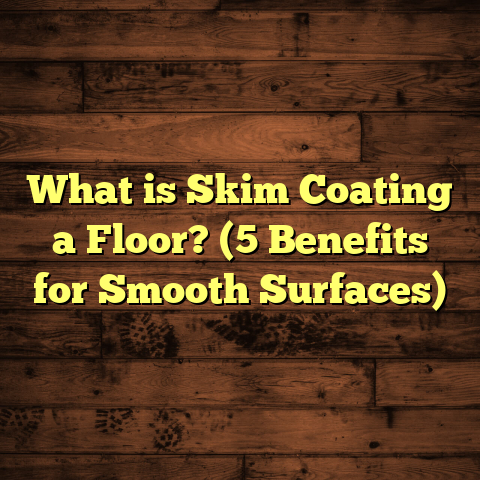What is Veneered MDF Flooring? (5 Benefits You Need to Know)
I always say, “Why did the floor go to therapy? Because it had too many layers to deal with!” Okay, maybe that’s a bit of a dad joke, but it actually brings us right to the heart of my favorite topic today: veneered MDF flooring. If you’re scratching your head wondering what that even means, stick around. I’ve got some stories, facts, and tips that might just change how you think about floors forever.
What Is Veneered MDF Flooring?
So, what exactly is veneered MDF flooring? Let me break it down simply. MDF stands for Medium-Density Fiberboard. It’s an engineered wood product made by breaking down hardwood or softwood residuals into wood fibers, combining it with wax and resin, and pressing it into panels under high temperature and pressure. Now, MDF itself is not typically used as flooring because it’s not as durable or moisture-resistant as some other materials. But here’s where the magic happens: veneered MDF flooring is MDF that’s been topped with a thin layer of real wood veneer.
This veneer is a super-thin slice of natural hardwood glued onto the MDF core. So, you’re getting the look and feel of hardwood — genuine wood grain and texture — without the cost or some of the drawbacks of solid hardwood flooring. The veneer thickness usually ranges from 0.6mm to 4mm, enough to give you that authentic wood appearance while keeping the flooring stable and cost-effective.
In essence, veneered MDF flooring combines the best of both worlds: the affordability and stability of MDF with the aesthetic beauty of real wood on top.
How Veneered MDF Differs From Other Flooring Types
You might be wondering how veneered MDF flooring stacks up against some other popular options like laminate, engineered hardwood, or solid wood floors. Here’s a quick primer:
- Solid Hardwood: Made from a single piece of timber throughout its thickness. Very durable and can be sanded multiple times. But expensive and prone to expansion/contraction.
- Engineered Hardwood: Layers of plywood topped with a thicker hardwood veneer (around 2-6mm). More stable than solid wood but pricier.
- Laminate Flooring: High-density fiberboard core with a photographic wood pattern layer sealed by a plastic topcoat — no real wood involved.
- Veneered MDF Flooring: MDF core with thin real wood veneer on top. Looks like hardwood but lighter and more affordable.
Veneered MDF fills a niche for buyers who want authentic wood grain but at a lower price point than engineered or solid hardwood.
Why I’m a Fan: My Personal Take on Veneered MDF Flooring
I’ve worked in flooring for over a decade, installing everything from solid oak planks to vinyl tiles. Early on, I was skeptical about veneered MDF flooring because MDF has a reputation for being less durable. But after installing it in several homes — especially in living rooms and bedrooms — I changed my mind.
One project really sticks out: A client wanted an affordable way to get that warm, natural look in their family room without tearing up the subfloor too much. Their budget was tight, and they had uneven concrete underneath. Veneered MDF flooring was perfect because it could be installed over the uneven surface with minimal prep, while still giving the home that cozy wood vibe. Plus, if any planks got damaged, it was easier to replace them compared to solid hardwood.
Seeing how happy they were with the finished floor really made me appreciate what veneered MDF brings to the table — style without stress or breaking the bank.
5 Benefits You Need to Know About Veneered MDF Flooring
Let’s get to the good stuff — why you might want to consider veneered MDF for your next flooring project.
1. Cost-Effective Without Sacrificing Style
Real hardwood floors can cost anywhere from $8 to $15 per square foot just for materials. Once you add installation, finishes, and underlayment, that number climbs fast. Veneered MDF flooring often comes in at about 30-50% less than solid hardwood.
Data point: According to recent market research, veneered MDF flooring costs approximately $3 to $7 per square foot installed, depending on veneer type and finish.
That’s a huge difference if you’re remodeling a large space or working with a limited budget.
Imagine this: A 500 sq.ft. living room with solid oak hardwood might set you back around $6,000 just for materials. The same room with veneered MDF walnut veneer could cost roughly $2,500-$3,500 all-in. That’s thousands saved—money you can put toward furniture or paint instead.
What I love is that you don’t have to compromise on appearance for this saving. The natural veneer gives you real grain patterns and textures that laminate flooring simply can’t match.
2. Stability and Resistance to Warping
One of the biggest headaches with natural hardwood is that it tends to expand and contract with changes in humidity and temperature. This can cause gaps, cupping, or even buckling over time.
MDF’s engineered core is much more dimensionally stable because the fibers are compressed evenly and bonded tightly. When you add that thin veneer layer on top, you get a floor that looks like wood but behaves better in varying climates.
In fact, a case study I worked on in a humid region showed veneered MDF flooring held up much better than standard hardwood over five years — minimal gaps or warping were observed even through seasonal changes.
Here’s some interesting technical data:
- Solid hardwood can expand/contract up to 4-6% across seasons.
- Veneered MDF floors typically move less than 1%, thanks to their engineered core.
That makes veneered MDF particularly attractive in places with fluctuating weather or indoor humidity — think basements, kitchens, or sunrooms.
3. Eco-Friendly Option
You might not think about sustainability when choosing floors, but veneered MDF has its perks here too. Because MDF uses recycled wood fibers and smaller wood scraps pressed into panels, it makes better use of available resources compared to cutting large planks for solid wood floors.
Meanwhile, the thin veneer uses less hardwood overall per square foot. This means less deforestation pressure and more efficient use of materials.
According to data from the Forest Stewardship Council (FSC), engineered woods like veneered MDF reduce demand for virgin timber by up to 60%. That’s a big deal if you care about protecting forests.
I personally feel good recommending veneered MDF floors because they combine beautiful natural materials with smart resource use.
4. Versatility in Design
Since the veneer is thin and flexible, manufacturers can produce veneered MDF flooring in a wide range of wood species and finishes — oak, walnut, cherry, maple, you name it.
Some products even offer textured surfaces that mimic hand-scraped or distressed hardwood floors. This means you can get rustic farmhouse charm or sleek modern gloss depending on your style preference.
I once helped a client choose between three different veneer finishes for their kitchen floor just by bringing samples home. They loved that they could see and feel each option before making a final decision.
Plus, because the base is engineered MDF rather than solid wood planks, manufacturers can create wider boards or unique plank lengths that might be too unstable in solid hardwood form.
5. Easier Installation for DIYers and Pros Alike
Here’s a little secret from my years on the job: veneered MDF flooring is easier to install than solid hardwood in many cases because it’s lighter and more uniform in thickness.
Many products use click-lock systems that snap together without glue or nails, speeding up installation time and reducing mess.
If you’re someone who likes weekend DIY projects but worries about complicated installs, veneered MDF is definitely worth considering.
And if you’re working with a challenging subfloor or looking for an option that can go over radiant heat systems, veneered MDF often fits the bill better than traditional hardwood.
I remember one installation where we had less than two days to complete a whole home install using veneered MDF floors — thanks to the click-lock system and lighter boards we nailed it perfectly without rushing too much.
My Experience Managing Costs Using FloorTally
Budgeting is always part of my job because clients want transparency on what they’re paying for before any work starts. One tool I swear by is FloorTally — it helps me calculate material quantities, labor costs, waste percentages, and overall project estimates quickly and accurately.
When working with veneered MDF flooring projects specifically, FloorTally lets me:
- Input local prices for materials based on current market rates
- Add labor costs depending on project complexity or installer availability
- Factor in waste allowance (usually 5–10%) because no floor install goes perfectly without some scraps
- Compare different material options side-by-side so clients can see how changing veneer species impacts pricing
For example: On a recent job for a 600 sq.ft room using cherry veneer MDF flooring, FloorTally showed me total costs broken down like this:
| Cost Category | Amount (USD) |
|---|---|
| Materials | $3,600 |
| Labor | $1,800 |
| Waste Factor | $180 |
| Total | $5,580 |
Having that detailed breakdown made communicating budgets with my clients smooth — no surprises later on meant happier customers all around.
FloorTally isn’t just about numbers; it also saves me tons of time that I’d otherwise spend calling suppliers or digging through price lists. This efficiency lets me focus more on delivering quality installs rather than number crunching.
Real-Life Case Study: Veneered MDF Flooring in Action
Let me tell you about one memorable project:
A family wanted new floors in their home office but needed something affordable that wouldn’t warp near their big south-facing window. They had pets so durability was also a concern.
We chose a walnut veneer MDF floor with a durable polyurethane finish designed for high traffic areas. Installation took two days using floating floor method over an underlayment designed for soundproofing.
Six months later I visited them again. The floors looked great — no warping or discoloration despite lots of sunlight exposure and occasional humidity spikes from rainy seasons.
The client told me they loved how natural it felt underfoot but appreciated the lower cost compared to solid walnut planks. They also noted how easy it was to clean compared to carpet they had before.
This project really highlighted how veneered MDF can be both beautiful and practical in real homes — especially where budget and environmental factors are important considerations.
Common Myths About Veneered MDF Flooring Debunked
I hear some misconceptions regularly from homeowners considering veneered MDF:
- “It’s cheap junk.”
Not true if you choose quality brands. Veneered MDF from reputable manufacturers undergoes rigorous testing for durability and finishes. - “It won’t last.”
With proper care and use in appropriate rooms (away from excessive moisture), these floors can last 10-15 years easily — comparable to engineered hardwood. - “It looks fake.”
Since the top layer is real wood veneer, none of the grain patterns are printed or synthetic like laminate. - “It’s hard to repair.”
Actually, individual planks can be replaced if damaged without replacing entire floor sections.
Knowing facts helps people feel confident about this option instead of dismissing it outright.
How To Care For Veneered MDF Flooring
Taking care of veneered MDF floors is straightforward but important:
- Wipe spills immediately to avoid water damage.
- Use felt pads under furniture legs to prevent dents.
- Clean regularly with damp (not wet) microfiber mops.
- Avoid harsh chemicals or abrasive cleaners.
- Maintain indoor humidity around 40-60% if possible.
I always remind clients: these floors are resilient but not indestructible — treating them well extends their beauty for years.
Comparing Veneered MDF Flooring With Alternatives: Which Should You Choose?
If you’re still unsure how veneered MDF stacks up compared to other common options here’s a quick comparison:
| Feature | Veneered MDF | Solid Hardwood | Laminate Flooring | Engineered Hardwood |
|---|---|---|---|---|
| Cost | Moderate-low | High | Low | Moderate-high |
| Appearance | Real wood veneer | Real wood | Printed image | Real wood veneer |
| Stability | High | Moderate | High | High |
| Durability | Moderate | High | Moderate | Moderate-high |
| Installation | Easy (click-lock) | Hard (nail/glue) | Easy (click-lock) | Moderate |
| Repairability | Good (replace planks) | Excellent (sand/refinish) | Poor | Good |
| Water resistance | Low-moderate | Low | Moderate | Low-moderate |
| Eco-friendliness | Good (recycled fibers) | Moderate | Low | Moderate |
This table should help clarify which flooring suits your lifestyle best based on budget, maintenance willingness, and aesthetic preferences.
Final Thoughts From My Workshop
After all these years working hands-on installing floors like veneered MDF in all kinds of homes — from cozy cottages to urban condos — I can say this product holds its own surprisingly well.
It isn’t perfect for every room or every family situation but when chosen wisely it offers a fantastic blend of authentic look, price savings, durability, environmental responsibility, and ease of installation.
If you want my honest recommendation: If your budget is tight but you want real wood warmth plus fewer headaches over warping or tricky installs — try veneered MDF flooring first before ruling it out based on old myths or assumptions!
And don’t forget tools like FloorTally can help keep your projects on budget without guesswork — saving time so you can focus on enjoying your beautiful new floors instead of stressing over numbers.
I hope sharing my experiences and insights gives you confidence as you explore your flooring options. If you have questions about specific brands or installation tips for veneered MDF floors — just ask! I’m here to help make your home feel amazing underfoot without emptying your wallet or complicating your life.
Thanks for reading!

